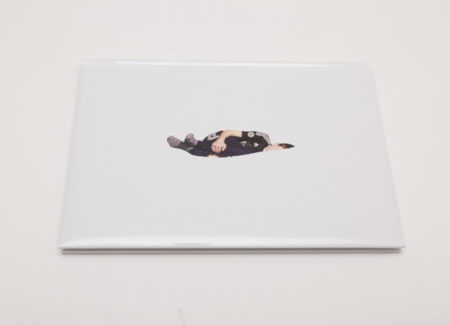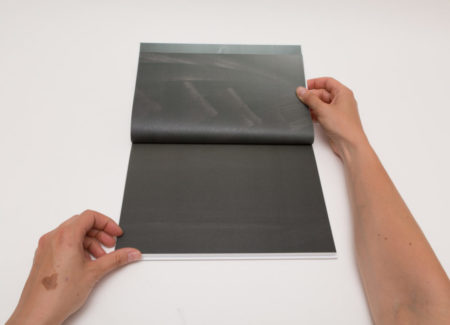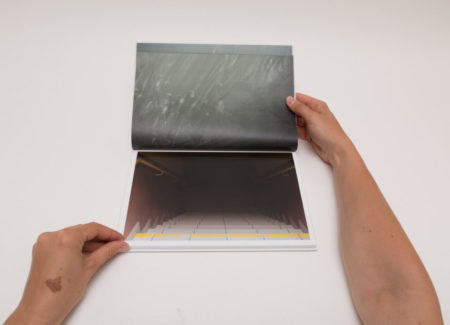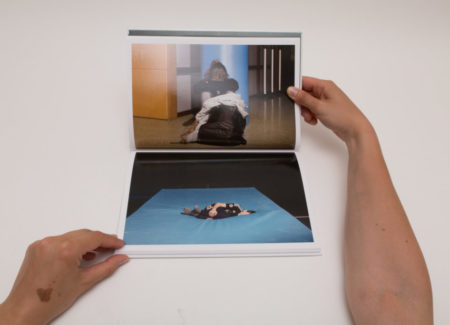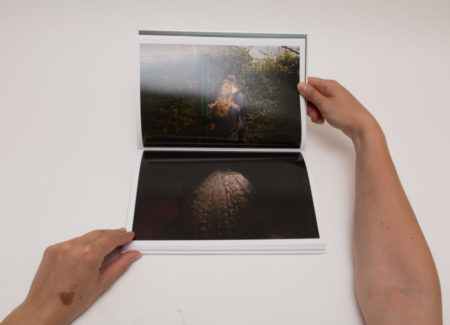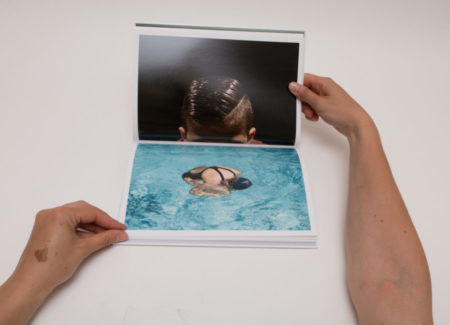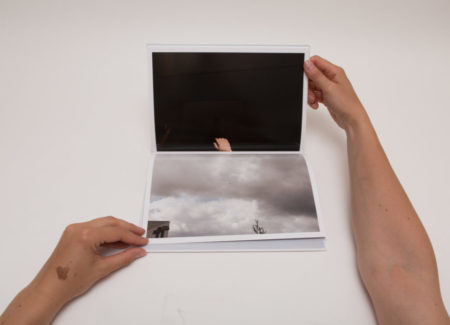JTF (just the facts): Co-published with Diaphane Éditions in 2016 (here). Hardcover, 102 pages, with 56 color photographs. In an edition of 600 copies. (Cover and spread shots below.)
Comments/Context: The Dutch photographer Florian van Roekel focuses his attention on everyday life and seemingly ordinary things, moments so banal that they easily escape our eyes. But he has shown a consistent talent for seeing the mundane from an unexpected angle, fully capturing our attention. Van Roekel got noticed when he self-published his first photobook How Terry likes His Coffee in 2010, produced as part of his final exam for the Bachelor of Photography at the Royal Academy of Arts in the Hague. His photographs were taken in five different companies, turning rather boring and uneventful office life into a surreal comedy. It became an instant hit. In 2011, Martin Parr selected van Roekel’s book as one the Best Books of the Decade.
Van Roekel’s most recent photobook is titled Le Collège, and the images were shot during a six month residency at Collège Jean Fernel in Clermont-de-l’Oise in northern France. The subject of his project is quite straightforward – the residents of the college and the routines of their daily life. But while the subject is not new, van Roekel goes far beyond traditional documentation and commonplace storytelling, creating a peculiar and curious representation of college culture.
The inventiveness starts with book’s white padded cover – on the front there is an image of a boy in a sports uniform lying down with his knees to his chest. We only see a part of his face and body, as if he was sinking into an enveloping soft cloud. The title is elegantly embossed on the back cover. Next, the book combines two different types of paper. It utilizes thin light paper at the beginning and the end, while the images in between are printed on a thick heavy glossy stock, making van Roekel’s bold color palette stand out even more. The end papers (and a good number of the following pages) serve as a metaphorical introduction to the project, as they reproduce a school blackboard in full bleed, with washed out chalk, some scratches, and partial elements of erased drawings and writing, evoking a whole set of emotions and associations related to the college years. And finally, the book looks like it might have typical vertical orientation, but it is actually horizontal, immediately upending our expectations and creating a unusual tactile dynamic, as we are forced to flip the pages with the binding at the top.
The first image in the book leads us down a flight of stairs as they disappear into the darkness, an Alice down the rabbit hole equivalent, letting us know we are off on an adventure. This picture is followed by a photo of a paper airplane on the granite floor, with a composition of a red fire extinguisher, alarm, and a trash bin on the wall coming next. With these fragmented shots of classrooms, halls, and isolated objects, van Roekel gives us only scraps of information that individually don’t provide many clues; yet seen together, these images recreate the charged atmosphere of the college, immersing us into its alternate reality.
The first person we actually encounter is a girl wearing a pink hoodie – standing next the hand dryer (probably in the bathroom), she is leaning towards the wall, her head down with one arm outstretched, reaching upward. It’s an unusual pose, with a quiet kind of gentleness. Van Roekel’s photographs aren’t typical portraits of students. He captures overlooked moments and small gestures, where dreams and thoughts seem to take over. Throughout the book, there is a feeling that everything has paused, with a leftover sense of tension lingering in the background.
In a portrait of a boy in a red t-shirt, the subject stands in the dark with his eyes peacefully closed as a hand touches his back, the meaning of the gesture pleasingly open-ended. Van Roekel offers us various photographs of students and teachers, but his images reveal little of their faces, frustrating our ability to assign a specific narrative. His people are often photographed from the back or tilted forward, with their faces covered by clothing or muffled in a group hug. Given this anonymity, the postures and gestures of the students take over compositional control, often transcending the doubts and uncertainty we might normally assume to be part of this kind of story.
Most of van Roekel’s photographs are rather dark, but his use of intense flash and nondescript backgrounds makes the subjects stand out, removing any unnecessary details. A girl submerged in the water of a swimming pool is paired with a portrait of a boy, yet we only see the slicked back hair on his head above his eyebrows, the blue water standing in contrast with black background of the second image. Another spread shows a teacher seated at a discussion table with a banana peel in his hand; we only see the lower part of his bearded face. The second image is a college couple caught kissing; the boy covers the girl with his body as her arm rests on his back. Again and again, we are given only part of the information, our fleeting glances catching only pieces of the whole scene.
As we come to the end of the book, we see a series of images of students raising their hands, the disembodied arms becoming isolated hands in the darkness, the answers seemingly becoming less and less confident. These are followed by two images of grey clouds (one with a tiny branch echoing the previous extended hand), as we get outside the campus into the unknown life of adulthood. The last few pages are almost blank, suggesting a world of open opportunities.
Seen together, van Roekel’s photographs create the atmosphere of a mysterious search, as he chronicles adolescence and its related set of emotions. In Le Collège, he has pared back the specific into something more abstractly universal, his fragments of college life equally representative of many other places and students. His pictures resonantly capture students as they struggle, grasping for connections, pushing on boundaries, and testing their limits.
Collector’s POV: Florian van Roekel is represented by Flatland Gallery in Amsterdam (here). His work has little secondary market history, so gallery retail remains the best option for those collectors interested in following up.
